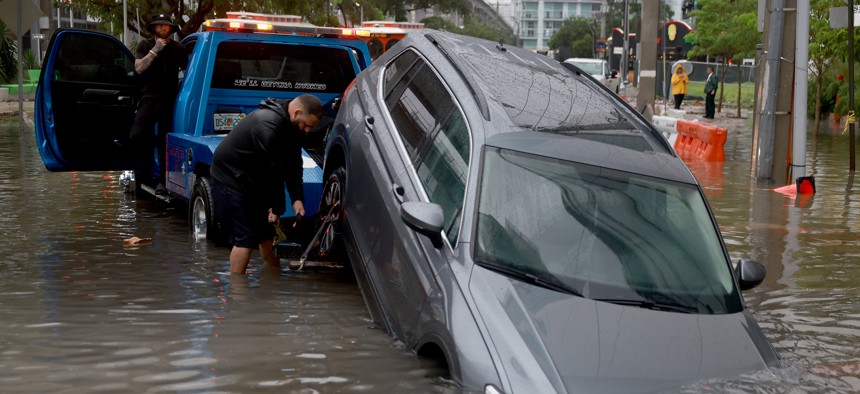Miami, other cities see costs rising because of flooding
Urban areas will see an increase in flooding by 2050, which will force local governments to spend much more on climate disasters, a recent report says.

A vehicle is prepared to be towed after it died while being driven through a flooded street caused by a deluge of rain on June 4, 2022 in Miami. Photo by Joe Raedle/Getty Images
Cities, including Miami, will see an increase in three types of flooding—river, coastal and wastewater—during the next three decades, events that will increase what local governments spend on climate disasters, according to a new report.
The analysis, titled Water Safe Cities, looks at members of C40 Cities, a network of nearly 100 cities worldwide collaborating on ways to confront climate change. The report includes 11 U.S. cities.
River Flooding
Damages caused by river flooding are the highest in North America and Asia, according to the report. These continents are where infrastructure and urban property are most at risk of flooding tied to rivers and where the damage is the most expensive.
Cities are tackling "riverine" flooding through a variety of programs to better manage watersheds, including projects to restore the natural environment along rivers.
River Flooding Per Capita Costs 2021, 2050*
Houston – $248, $219
New Orleans – $198, $484
New York City – $98, $141
Miami – $66, $80
Boston – $42, $53
Los Angeles – $20, $29
San Francisco – $40, $42
Philadelphia – $16, $31
Phoenix – $15, $48
Washington, D.C. – $14, $25
Chicago – $5, $9
The river flooding costs are based on 2015 population numbers. Houston is the only U.S. city on the list whose costs will shrink during the next three decades, although the report does not explain why.
*The 2050 figure is based on a global warming modeling scenario known as RCP 8.5, or Representative Concentration Pathway 8.5.
Stormwater Flooding
Stormwater flooding often causes major disruptions to drivers and transit commuters, the report notes. In recent years, for example, Washington D.C., experienced intense downpours that flooded its Metro subway stations.
New Orleans and New York are building several adaptive nature-based solutions: rain gardens and bioswales, which are landscape channels designed to collect stormwater runoff and remove debris and pollution and then soak the water into the ground.
Coastal Flooding
The report said that the more frequent and intense weather patterns could lead to sudden flooding along coastlines, as seen with Hurricane Sandy. Damages from the superstorm that devastated New York and New Jersey in 2012 cost more than $60 billion.
According to the report, restoring wetlands can reduce coastal flooding. It points out that during Hurricane Sandy, wetlands helped prevent about $625 million in property damage in the affected areas, and that coastal wetlands throughout the U.S. provide storm protection worth about $23 billion per year.
The report also states that cities need to develop an integrated water management approach with the federal government and regional groups to better combat coastal flooding.
However, the analysis doesn’t show that there will be more significant coastal flooding in the next few decades. Of the 11 U.S. cities studied, only San Francisco and Seattle will see some increase in coastal flooding by 2050.
Flood Mitigation Solutions
There are a number of steps local and state governments can take to quell the three types of flooding, according to the report. They can:
- Develop an emergency response plan to protect residents from flooding.
- Implement river catchment management, including river basin plans and buffer protection.
- Add green solutions for water permeability and flood protection, like floodplains, green riverbanks and rain gardens.
- Build natural solution barriers such as mangroves.
- Design artificial barriers like seawalls and flood gates.
In the U.S., every dollar invested in flood protection saves up to $318 in damages, according to the report. In addition, adaptation measures can prevent job losses and increase employment growth.
The Water Safe Cities report was produced by C40 Cities, the Institute for Environmental Studies and Climate Adaptation Services, in partnership with the Grundfos Foundation. It looks at current costs and estimated future financial effects of flooding and drought for 97 cities worldwide and what these climate-related events could mean for residents in those places.
For more information from the report, click here.
A version of this story was previously published on Route Fifty.
NEXT STORY: Florida among states shifting road safety dollars away from safety programs